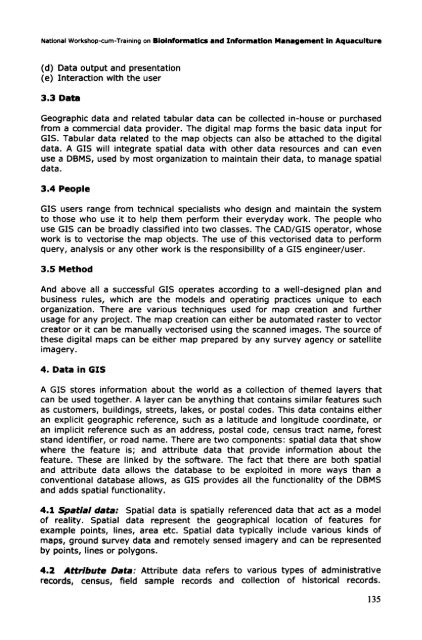4 - Central Institute of Brackishwater Aquaculture
4 - Central Institute of Brackishwater Aquaculture
4 - Central Institute of Brackishwater Aquaculture
Create successful ePaper yourself
Turn your PDF publications into a flip-book with our unique Google optimized e-Paper software.
National Workshop-cum-Tra~ning on Biolnforrnatics and Information Management in <strong>Aquaculture</strong><br />
(d) Data output and presentation<br />
(e) Interaction with the user<br />
3.3 Data<br />
Geographic data and related tabular data can be collected in-house or purchased<br />
from a commercial data provider. The digital map forms the basic data input for<br />
GIs. Tabular data related to the map objects can also be attached to the digital<br />
data. A GIs will integrate spatial data with other data resources and can even<br />
use a DBMS, used by most organization to maintain their data, to manage spatial<br />
data.<br />
3.4 People<br />
GIs users range from technical specialists who design and maintain the system<br />
to those who use it to help them perform their everyday work. The people who<br />
use GIS can be broadly classified into two classes. The CADIGIS operator, whose<br />
work is to vectorise the map objects. The use <strong>of</strong> this vectorised data to perform<br />
query, analysis or any other work is the responsibility <strong>of</strong> a GIs engineer/user.<br />
3.5 Method<br />
And above all a successful GIs operates according to a well-designed plan and<br />
business rules, which are the models and operating practices unique to each<br />
organization. There are various techniques used for map creation and further<br />
usage for any project. The map creation can either be automated raster to vector<br />
creator or it can be manually vectorised using the scanned images. The source <strong>of</strong><br />
these digital maps can be either map prepared by any survey agency or satellite<br />
imagery.<br />
4. Data in GIS<br />
A GIS stores information about the world as a collection <strong>of</strong> therned layers that<br />
can be used together. A layer can be anything that contains similar features such<br />
as customers, buildings, streets, lakes, or postal codes. This data contains either<br />
an explicit geographic reference, such as a latitude and longitude coordinate, or<br />
an implicit reference such as an address, postal code, census tract name, forest<br />
stand identifier, or road name. There are two components: spatial data that show<br />
where the feature is; and attribute data that provide information about the<br />
feature. These are linked by the s<strong>of</strong>tware. The fact that there are both spatial<br />
and attribute data allows the database to be exploited in more ways than a<br />
conventional database allows, as GIs provides all the functionality <strong>of</strong> the DBMS<br />
and adds spatial functionality.<br />
4.1 Spatial data: Spatial data is spatially referenced data that act as a model<br />
<strong>of</strong> reality. Spatial data represent the geographical location <strong>of</strong> features for<br />
example points, lines, area etc. Spatial data typically include various kinds <strong>of</strong><br />
maps, ground survey data and remotely sensed imagery and can be represented<br />
by points, lines or polygons.<br />
4.2 Attribute Data: Attribute data refers to various types <strong>of</strong> administrative<br />
records, census, field sample records and collection <strong>of</strong> historical records.

















